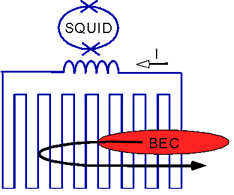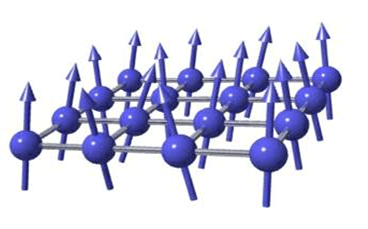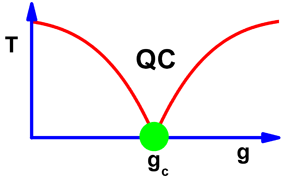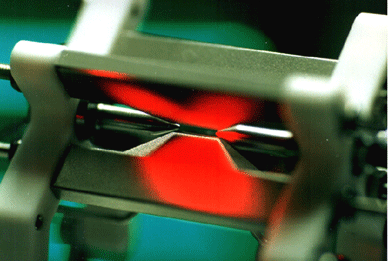About CO.CO.MAT Research
In contrast to classical matter, quantum matter allows for coherent superposition of states and entanglement among sub-systems. This basic fact implies that the accessible state space increases drastically by enlarging the number of degrees of freedom. Thus, quantum matter leads to a spectacular increase in the variety of attainable physical properties and, as already known from condensed matter physics, allows for a variety of collective phenomena such as superfluidity or superconductivity. However, until recently, the ability to manipulate these systems or parts of them was rather restricted. Such restrictions are nowadays lifted in many mesoscopic systems, where physical properties of single quantum mechanical degrees of freedom can be fine-tuned. An extension of such capabilities can be foreseen in quantum gases, where not only external parameters but also geometry, potentials and forms of interaction can be readily controlled. A common goal of our joint effort of quantum opticians and solid state physicists is to extend and exploit the present ability to control and engineer many-body quantum systems, linking the common underlying physics in mesoscopic systems and quantum gases.

In this context it is our goal to generate new states of matter by controlling quantum correlations in the gaseous, liquid, and solid state. Examples for new states of matter are supersolids, spin-liquids, ordered spin states under the influence of long range interactions and spinor gases. Besides characterizing the (quantum) phase diagrams and the physical properties, we aim to control dynamic cooperative states by time dependent tuning of quantum correlations. Starting from well controlled few body systems which can still be theoretically handled, we intend to gain an understanding of large-scale many-body quantum physics by studying their scaling behaviour. This is a decisive prerequisite to transfer the progress in quantum control into material science. The limitations due to decoherence processes will be studied in model systems and by local quantum optical probes in contact with solid state systems, as well as in coupled solid state systems themselves.
Over the last decades extraordinary progress has been made in the coherent control of single quantum systems such as isolated atoms, molecules, and in man-made systems such as single-electron transistors and quantum dots. Recent developments in dealing with few particle systems in atom traps have impressively demonstrated the controlled generation of entanglement and indeed first implementations of quantum algorithms. Mesoscopic solid-state physics is progressing equally rapidly in its ability to combine single and well understood units in a controlled way to tailor many-body quantum systems. Therefore these two branches of physics (quantum gases and mesoscopic systems) are rapidly moving in the same direction and provide a fruitful ground for new common developments. Hybrid quantum systems which are physically coupling mesoscopic solidstate systems and quantum optical systems have seen an impressive progress over the last years and we will extend our activity within this research effort. In more detail we will put the common perspectives into reality in the following fields of research:
Quantum correlations and quantum phase transitions are among the most prominent representatives of many-body quantum physics. Quantum correlated spin systems can exist in very different environments, but their physical behaviour is generic. Similarly, phase transitions driven by quantum fluctuations show a generic behaviour irrespective of their realization.
In view of applications in magnetism, spintronics and materials science, the ability to tune quantum correlations in general (project area A) and in hybrid quantum systems (project area C), e.g. in spin systems and beyond, and to find and control new states of matter and possible quantum phase transitions (project area B) is a central common goal in this joint effort.

Closely related realizations in atoms, molecules and solids will be investigated for this purpose. As the theoretical understanding is often restricted to a small number of coupled units, well controlled model systems will be used to investigate the scaling behaviour. Here, quantum gases and mesoscopic systems provide new control parameters and well defined model systems, which will allow us to qualitatively progress in our understanding of many-body quantum physics. But we also make contact to real materials like oxidelayers which can be controlled, characterized and optimized on the single atom level.
Mesoscopic systems under investigation in project area A are simple and complex quantum dots in a two-dimensional electron gas (2DEG) (A1, A6). In both projects the quantum correlations under the influence of tunable decoherence and out of equilibrium are investigated. In A1 an electrostatically coupled quantum dot system could be demonstrated as a pseudo-spin Kondo-system. The novel theoretical methods developed in B4 will now be directly applied to the system investigated in A1 within the novel project A6. This development between the MPI and University of Stuttgart is a direct consequence of the fruitful discussions among the respective SFB project leaders.

The conceptually related situation in quantum gases are driven impurities, which are for example subject of the novel project A7 which will investigate tunable ionic impurities in quantum gases. Although the former project A4 on atomic impurities in a Bose-Einstein condensate has been moved as project B6 to the B section, there is still a large overlap with the projects A1 and A6 and A7. Within A4 decoherence and dephasing mechanisms in a driven (out of equilibrium) system of Rydberg impurities have been investigated successfully. The investigation of Rydberg impurities started on the single particle level but quickly evolved into a mesoscopic system as due to the Rydberg blockade up to 10000 atoms share one excitation. This system is therefore directly connected to the quantum dot work in area A but also in C. These mesoscopic ensembles carrying the Rydberg excitation show interesting manybody physics as a quantum phase transition of Rydberg impurities is expected. This project is a good example on how we extend our understanding from single via few-body to many body phenomena and has consequently been moved to the B area.
After the successful demonstration of coherent control of single molecular magnets in the first funding period of project A3 it is now heading towards cavity QED using magnetic molecules. This is a result of intense discussions between the SFB members from solid state physics and quantum optics involving all locations of the SFB. It is therefore a paradigm project for common perspectives within this SFB. Here besides the expertise of A3 in Stuttgart also the expertise of A5 on the design of superconducting strip line resonators in Tübingen as well as the quantum optics background of a number of SFB members initiated this novel approach to light-matter states.
Coherent effects of dipolar coupling are subject of the projects on dipolar Bose-Einstein Condensates (BEC) (A2). After the investigation of the first purely dipolar quantum gas in the first funding period the second funding period the activity will branch out into two directions: Mesoscopic quantum states in tailored potentials and the investigation of fermionic dipolar atoms. Here it is our goal to investigate novel states of matter by tailoring interactions and geometry.
In A5, a tuneable spin system based on fractional Josephson vortices is investigated, which will have model character, once the quantum regime is reached. In the first funding period, coupled molecular semi-fluxon states have been investigated. Already before reaching the quantum regime there is an overlap with A2 where nonlinear nonlocal dynamics e.g. solitary solutions of the underlying meanfield equation will be investigated. A5 has proven to be a very good example for the collaboration between solid state experimentalists in Tübingen and quantum optics theorists from Ulm.
The projects in the area A have developed considerably into the targeted direction of the SFB, namely common perspectives of solid state physics and quantum and atom optics. A1 has found a direct theoretical partner A6 which is the result of the first funding period. A3 has developed from a mostly solid state background into a project with strong quantum optics aspects. A5 is now ready to enter the quantum regime and has undergone joint development with project leaders form quantum optics and solid state physics.
The control of quantum phase transitions in project area B is pursued both experimentally and theoretically. This area has undergone some important changes during the first funding period. The first two projects B1 and B2 were finished as the project leaders left the SFB. Prof. Weitz and Prof. Santos accepted attractive offers on chairs in Bonn and Hannover. PD Dr. Walser very recently accepted a position in the local optical industry. Therefore, also B5 came to an end. In project B4, the theoretical understanding of dynamical behaviour around quantum phase transitions was improved. The theoretical understanding of this non-equilibrium behaviour is so far very poor and can be tackled by numerical methods developed in the first funding period. As a replacement of Prof. Santos, Stuttgart managed to attract Prof. Büchler to the University of Stuttgart, who has a strong condensed matter background but has focused already very early on the physics of quantum gases. Therefore he is the perfect partner for many projects within this SFB and is contributing to two new projects B6 and B8.
We have taken care that part B is considerably strengthened by two experimental projects B6 and B7 in the new funding period. B7 is a project which is based on the spectacular results of the Tübingen group on the formation of a mixed species quantum gas of Li and Rb. Based on this the physics of quantum phase transitions in Bose Fermi mixtures in dynamical optical lattices will be studied and confronted with numerial simulations in project B4.
The B6 project emerged from the very fruitful cooperation between the Büchler and the Pfau group after the arrival of Prof. Büchler.
In the novel B8 project by Prof. Büchler and PD Dr. Wessel strongly interacting dipolar gases are studied with direct link to project A2.
In the first funding period we included as a visionary goal, the engineering of hybrid quantum systems (project area C) at the interface between solid-state physics and quantum optics. Here we concentrate on the possibilities to control and engineer solidstate systems by quantum optical means and vice versa. In this area, not only common conceptual goals are pursued but also common methods will be developed. It was expected that the synergy between the fields of mesoscopic physics and quantum optics is developing within the research programme to a level where the differences between the two communities vanish and a new research field emerges. Therefore, we included several projects that bring quantum optical systems physically in touch with mesoscopic solid state systems. This anticipation was fulfilled. Now the field of mesoscopic quantum optics is an internationally expanding field where our projects have taken a leading role. As expected during the course of the first funding period new experimental project ideas came up and are now included in the SFB by project B6 and C9.
After the project C1 came to an end due to the fact that Prof. Weitz moved to Bonn, Tübingen university managed to offer Prof. Fortágh a full professor position, after he received a very attractive offer from the U.K. He not only took over the project C2 on a superconducting microtrap (in collaboration with D. Kölle), where they recently measured the impact of the Meissner effect for cold atoms, but he also brought a very innovative hybrid system into the SFB, namely the investigation of the interaction between nanotubes and Bose-Einstein condensates. This project was awarded with the NanoFutur Prize of the BMBF and was immediately included into the SFB (C9), as it stands for the very challenging and fascinating perspectives of experiments that physically bring mesoscopic quantum systems in touch with quantum gases.

On the other hand non-classical states of light are generated by coupled quantum dot molecules (C3). Tuning of the distance between the dots and by electric fields provided a deep insight into the quantum interface between light and solid matter. As O. Schmidt left Stuttgart due to a call to Dresden, the SFB/TRR21 supported via the lump-funds the setup of local epitaxial growth facilities at the newly founded institute of Prof. Michler. As a consequence, the SFB project C3 has its own material supply in house. Quantum coherence was also at the heart of project C4, where stunning decoherence times were achieved. As a consequence, quantum entanglement of electron and nuclear spins could be prepared and characterized via a combination of optical and microwave methods. This project has led to a world-wide explosion in the activity on coherent control and quantum information processing in diamond. C5 has reached a high visibility with a micro structured segmented ion trap where ions have been ground state cooled for coherent quantum state engineering.
In our joint effort of experimental and theoretical physicists, both the new perspectives and the limitations of quantum control of coherent many-body systems was and will be investigated. This common enterprise between quantum optics and solid-state physics provided access to a hierarchy of complexity and to various means of quantum control. It includes well defined model systems and potential candidates for future applications as quantum materials or devices. All examined systems are constructed from a more or less regular arrangement of effective single quantum units with a few degrees of freedom. More collective quantum effects are expected using variable coherent control parameters such as tuning of the coupling among these systems as well as their geometry and dimensionality. The dynamical control of these parameters is expected to lead to a vast number of non-equilibrium quantum phenomena, which will be a focus of our research activities.
Overview over the achieved goals of the first funding period
The common goals of all the SFB projects are
- - find new states of matter,
- - tailor new dynamic cooperative quantum states,
- - understand the scaling behaviour of their properties from few body to many body physics
- - probe and influence the effects of decoherence and
- - control light matter states.
The following table lists in very compact form the scientific highlights and first steps towards the realization of the goals of the SFB. A significant number of these results were actually covered in the media in various forms.